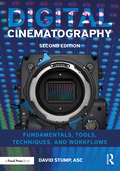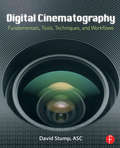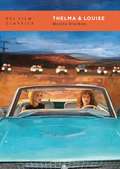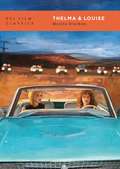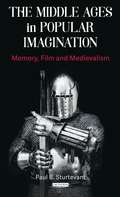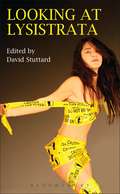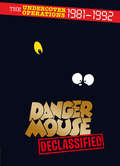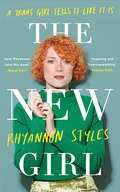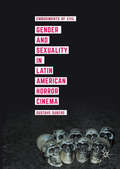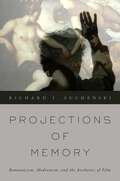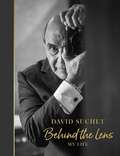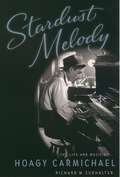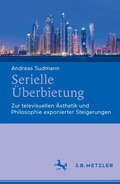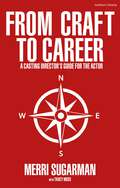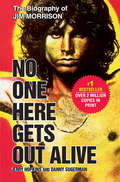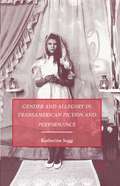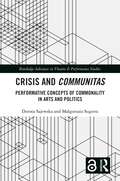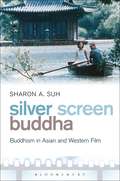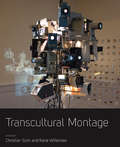- Table View
- List View
Digital Cinematography: Fundamentals, Tools, Techniques, and Workflows
by David Stump, ASCToday’s successful cinematographer must be equal parts artist, technician, and business-person. The cinematographer needs to master the arts of lighting, composition, framing and other aesthetic considerations, as well as the technology of digital cameras, recorders, and workflows, and must know how to choose the right tools (within their budget) to get the job done. David Stump’s Digital Cinematography focuses on the tools and technology of the trade, looking at how digital cameras work, the ramifications of choosing one camera versus another, and how those choices help creative cinematographers to tell a story.This book empowers the reader to correctly choose the appropriate camera and workflow for their project from today’s incredibly varied options, as well as understand the ins and outs of implementing those options. Veteran ASC cinematographer David Stump has updated this edition with the latest technology for cameras, lenses, and recorders, as well as included a new section on future cinematographic trends. Ideal for advanced cinematography students as well as working professionals looking for a resource to stay on top of the latest trends, this book is a must read.
Digital Cinematography: Fundamentals, Tools, Techniques, and Workflows
by David StumpFirst published in 2014. Routledge is an imprint of Taylor & Francis, an informa company.
Digital Cinematography: Fundamentals, Tools, Techniques, and Workflows
by David StumpFirst published in 2014. Routledge is an imprint of Taylor & Francis, an informa company.
Thelma & Louise (BFI Film Classics)
by Marita SturkenThelma & Louise, directed by Ridley Scott and written by Callie Khouri, sparked a remarkable public discussion about feminism, violence, and the representation of women in cinema on its release in 1991. Subject to media vilification for its apparent justification of armed robbery and manslaughter, it was a huge hit with audiences composed largely but not exclusively of women who cheered the fugitive central characters played by Susan Sarandon and Geena Davis. Marita Sturken examines Thelma & Louise as one of those rare films that encapsulates the politics of its time. She discusses the film's reworking of the outlaw genre, its reversal of gender roles, and its engagement with the complex relationship of women, guns adn the law. The insights of director Scott, screenwriter Khouri as well as Davis and Sarandon are deployed in an analysis of Thelma & Louise and the controversies it sparked. This is a compelling study of a landmark in 1990s American cinema.In her foreword to this new edition, Sturken looks back on the film's reception at the time of its release, and considers its continuing resonances and topicality in the age of #MeToo.
Thelma & Louise (BFI Film Classics)
by Marita SturkenThelma & Louise, directed by Ridley Scott and written by Callie Khouri, sparked a remarkable public discussion about feminism, violence, and the representation of women in cinema on its release in 1991. Subject to media vilification for its apparent justification of armed robbery and manslaughter, it was a huge hit with audiences composed largely but not exclusively of women who cheered the fugitive central characters played by Susan Sarandon and Geena Davis. Marita Sturken examines Thelma & Louise as one of those rare films that encapsulates the politics of its time. She discusses the film's reworking of the outlaw genre, its reversal of gender roles, and its engagement with the complex relationship of women, guns adn the law. The insights of director Scott, screenwriter Khouri as well as Davis and Sarandon are deployed in an analysis of Thelma & Louise and the controversies it sparked. This is a compelling study of a landmark in 1990s American cinema.In her foreword to this new edition, Sturken looks back on the film's reception at the time of its release, and considers its continuing resonances and topicality in the age of #MeToo.
The Middle Ages in Popular Imagination: Memory, Film and Medievalism (New Directions in Medieval Studies)
by Paul B. SturtevantIt is often assumed that those outside of academia know very little about the Middle Ages. But the truth is not so simple. Non-specialists in fact learn a great deal from the myriad medievalisms – post-medieval imaginings of the medieval world – that pervade our everyday culture. These, like Lord of the Rings or Game of Thrones, offer compelling, if not necessarily accurate, visions of the medieval world. And more, they have an impact on the popular imagination, particularly since there are new medievalisms constantly being developed, synthesised and remade. But what does the public really know? How do the conflicting medievalisms they consume contribute to their knowledge? And why is this important? In this book, the first evidence-based exploration of the wider public's understanding of the Middle Ages, Paul B. Sturtevant adapts sociological methods to answer these important questions. Based on extensive focus groups, the book details the ways – both formal and informal – that people learn about the medieval past and the many other ways that this informs, and even distorts, our present. In the process, Sturtevant also sheds light, in more general terms, onto the ways non-specialists learn about the past, and why understanding this is so important. The Middle Ages in Popular Imagination will be of interest to anyone working on medieval studies, medievalism, memory studies, medieval film studies, informal learning or public history.
Looking at Lysistrata: Eight Essays and a New Version of Aristophanes' Provocative Comedy
by David StuttardIn Aristophanes' Lysistrata, the women of Athens, fed up with the war against Sparta, go on a sex strike and barricade themselves into the acropolis to persuade their husbands to vote against the war. It is the most often performed of all Aristophanes' comedies. It is also, perhaps, the most misunderstood. This collection of essays by eight leading academics - written for sixth-form students and the general public alike - sets the play firmly in its historical and social context, while exploring Aristophanes' purpose in writing it and considering the responses of modern audiences and directors. The collection has been assembled and edited by David Stuttard, whose energetic new performing version of the play is included in this volume. Contributors include: Alan Beale; Edith Hall; Lorna Hardwick; James Morwood; Martin Revermann; James Robson; Alan H. Sommerstein; Michael Walton.
Looking at Lysistrata: Eight Essays and a New Version of Aristophanes' Provocative Comedy
by David StuttardIn Aristophanes' Lysistrata, the women of Athens, fed up with the war against Sparta, go on a sex strike and barricade themselves into the acropolis to persuade their husbands to vote against the war. It is the most often performed of all Aristophanes' comedies. It is also, perhaps, the most misunderstood. This collection of essays by eight leading academics - written for sixth-form students and the general public alike - sets the play firmly in its historical and social context, while exploring Aristophanes' purpose in writing it and considering the responses of modern audiences and directors. The collection has been assembled and edited by David Stuttard, whose energetic new performing version of the play is included in this volume. Contributors include: Alan Beale; Edith Hall; Lorna Hardwick; James Morwood; Martin Revermann; James Robson; Alan H. Sommerstein; Michael Walton.
Danger Mouse: Declassified
by Sir Arthur Stuyvesant Quinn-Flossy IV (Bart.)Crumbs! Danger Mouse’s most sensitive, scintillating and secret operations have been revealed for the first time in this top-secret dossier. Kept under lock and key at MI5 (or is it MI6? One of the Mouse Intelligence agencies, anyway...) for over 35 years, finally discover how DM saves London, the world and, most importantly, Penfold in fantastically absurd adventures. Be shocked and surprised, amazed and astounded by stories including the audacious theft of a chunk of ozone; the planned sabotage of the Royal wedding; and a sinister attempt by Jeremy Beagle to take over the airwaves.Cor blimey!
The New Girl: A Trans Girl Tells It Like It Is
by Rhyannon Styles'Inspiring and heart-wrenching' Paloma Faith 'Love Rhyannon. Love this book' Grace Dent The remarkable transgender memoir you won't stop hearing about. Rhyannon Styles will do for transgender what Matt Haig did for mental health. Elle columnist Rhyannon Styles tells her unforgettable life story in THE NEW GIRL, reflecting on her past and charting her incredible journey from male to female. A raw, frank and utterly moving celebration of life.Imagine feeling lost in your own body. Imagine spending years living a lie, denying what makes you 'you'. This was Ryan's reality. He had to choose: die as a man or live as a woman.In 2012, Ryan chose Rhyannon. At the age of thirty she began her transition, taking the first steps on the long road to her true self.Rhyannon holds nothing back in THE NEW GIRL, a heartbreakingly honest telling of her life. Through her catastrophic lows and incredible highs, she paints a glorious technicolour picture of what it's like to be transgender. From cabaret drag acts, brushes with celebrity and Parisian clown school, to struggles with addiction and crippling depression, Rhyannon's story is like nothing you've read before.Narrated with searing honesty, humour and poignancy, THE NEW GIRL is a powerful book about being true to ourselves, for anyone who's ever felt a little lost.
Gender and Sexuality in Latin American Horror Cinema: Embodiments of Evil
by Gustavo SuberoGender and Sexuality in Latin American Horror Cinema explores the different mechanisms and strategies through which horror films attempt to reinforce or contest gender relations and issues of sexual identity in the continent. The book explores issues of machismo, marianismo, homosociality, bromance, among others through the lens of horror narratives and, especially, it offers an analysis of monstrosity and the figure of the monster as an outlet to play out socio-sexual anxieties in different societies or gender groups. The author looks at a wide rage of films from countries such as Cuba, Peru, Mexico and Argentina and draws points of commonality, as well as comparing essential differences, between the way that horror fictions – considered by many as low-brow cinema - can be effective to delve into the way that sexuality and gender operates and circulates in the popular imaginary in these regions.
Projections of Memory: Romanticism, Modernism, and the Aesthetics of Film
by Richard I. SuchenskiProjections of Memory is an exploration of a body of innovative cinematic works that utilize their extraordinary scope to construct monuments to the imagination that promise profound transformations of vision, selfhood, and experience. This form of cinema acts as a nexus through which currents from the other arts can interpenetrate. By examining the strategies of these projects in relation to one another and to the larger historical forces that shape them--tracing the shifts and permutations of their forms and aspirations--Projections of Memory remaps film history around some of its most ambitious achievements and helps to clarify the stakes of cinema as a twentieth-century art form.
Projections of Memory: Romanticism, Modernism, and the Aesthetics of Film
by Richard I. SuchenskiProjections of Memory is an exploration of a body of innovative cinematic works that utilize their extraordinary scope to construct monuments to the imagination that promise profound transformations of vision, selfhood, and experience. This form of cinema acts as a nexus through which currents from the other arts can interpenetrate. By examining the strategies of these projects in relation to one another and to the larger historical forces that shape them--tracing the shifts and permutations of their forms and aspirations--Projections of Memory remaps film history around some of its most ambitious achievements and helps to clarify the stakes of cinema as a twentieth-century art form.
Behind the Lens: My Life
by David SuchetIn the early days of my career, I didn't think I stood a hope in hell. Look at me: I'm short, stocky, slightly overweight, deep of voice, passionate, dark haired, olive skinned, hardly your typical Englishman. What chance did I have, going into the world of British theatre?David Suchet has been a stalwart of British stage and screen for fifty years. From Shakespeare to Oscar Wilde, Freud to Poirot, Edward Teller to Doctor Who, Harold Pinter to Terence Rattigan, Questions of Faith to Decline and Fall, right up to 2019's The Price, David has done it all. Throughout this spectacular career, David has never been without a camera, enabling him to vividly document his life in photographs. Seamlessly combining photo and memoir, Behind the Lens is the story of David's remarkable life, showcasing his wonderfully evocative photographs and accompanied by his insightful and engaging commentary.In Behind the Lens, David discusses his London upbringing and love of the city, his Jewish roots and how they have influenced his career, the importance of his faith, how he really feels about fame, his love of photography and music, and his processes as an actor. He looks back on his fifty-year career, including reflections on how the industry has changed, his personal highs and lows, and how he wants to be remembered. And, of course, life after Poirot and why he's still grieving for the eccentric Belgian detective. An autobiography with a difference, this is David Suchet as you've never seen him before - from behind the lens.
Stardust Melody: The Life and Music of Hoagy Carmichael
by Richard M. SudhalterGeorgia on My Mind, Rockin' Chair, Skylark, Lazybones, and of course the incomparable Star Dust--who else could have composed these classic American songs but Hoagy Carmichael? He remains, for millions, the voice of heartland America, eternal counterpoint to the urban sensibility of Cole Porter and George Gershwin. Now, trumpeter and historian Richard M. Sudhalter has penned the first book-length biography of the man Alec Wilder hailed as "the most talented, inventive, sophisticated and jazz-oriented of all the great songwriters--the greatest of the great craftsmen." Stardust Melody follows Carmichael from his roaring-twenties Indiana youth to bandstands and recording studios across the nation, playing piano and singing alongside jazz greats Jack Teagarden, Benny Goodman, Tommy and Jimmy Dorsey, and close friends Bix Beiderbecke and Louis Armstrong. It illuminates his peak Hollywood years, starring in such films as To Have and Have Not and The Best Years of Our Lives, and on radio, records and TV. With compassionate insight Sudhalter depicts Hoagy's triumphs and tragedies, and his mounting despair as rock-and-roll drowns out and lays waste to the last days of a brilliant career. With an insider's clarity Sudhalter explores the songs themselves, still fresh and appealing while reminding us of our innocent American yesterdays. Drawing on Carmichael's private papers and on interviews with family, friends and colleagues, he reveals that "The Old Music Master" was almost as gifted a wordsmith as a shaper of melodies. In all, Stardust Melody offers a richly textured portrait of one of our greatest musical figures, an inspiring American icon.
Serielle Überbietung: Zur televisuellen Ästhetik und Philosophie exponierter Steigerungen
by Andreas SudmannAls serielle Figur der Fortsetzung und Variation prägt die Dynamik der Überbietung seit jeher die Produkte und Praktiken der Medienkultur. In den Diskursen der Spätmoderne hat Überbietung – als Logik einer vermeintlich bloß quantitativen Steigerung ohne qualitativen Mehrwert – primär einen negativen Status. Damit steht ihre Wahrnehmung im deutlichen Kontrast zu jener der Serie, die in den letzten zwei Jahrzehnten eine enorme Aufwertung erfahren hat. Ihre Nobilitierung ist vor allem das Verdienst amerikanischer Fernsehserien, die wiederum auch die Formen und Verfahren der Überbietung in einem neuen Licht erscheinen lassen. Anhand zahlreicher historischer wie aktueller Beispiele stellt Andreas Sudmanns Untersuchung dar, wie Fernsehserien Überbietungsprozesse nicht nur veranschaulichen, sondern sie auch für ihre ästhetischen Zwecke reflexiv und produktiv nutzen
Unscripted: My Ten Years in Telly
by Alan SugarAs the star of the award-winning BBC series The Apprentice, Alan Sugar has won millions of fans who tune in to watch his mix of business wisdom, witty putdowns and ability to cut straight through bullshit. But how did the famously straight-talking entrepreneur end up fronting one of our most successful and long-running shows, and why were some of his biggest challenges during his ten years in television to be found outside the boardroom and off camera? In Unscripted, Alan Sugar reveals all this and more as he embarks on a new and sometimes bewildering career. He describes how he lost patience with some of the luvvies, wafflers and wannabes he encountered along the way, and tells us what he really thought of some of the tasks and candidates he came across during the making of The Apprentice, giving his reaction to the egos and the backbiting as well as the genuine talent that shone through. He explains how he brought on board Nick Hewer, Margaret Mountford and Karren Brady, what became of the winners when the cameras stopped rolling - and how working on the show has inspired him and many others. As with his previous books, What You See Is What You Get and The Way I See It, there is no ghostwriter; this is written by the man himself. And, as ever, it is honest, funny and outspoken - Alan Sugar at his entertaining best.
From Craft to Career: A Casting Director’s Guide for the Actor
by Merri Sugarman Tracy MossPractical, positive and uplifting, the advice in this book is designed to lead to the best outcomes possible for you, the actor, making the transition from craft to career.The reader is given insight into the various types of casting directors across the industry and how that practical knowledge can benefit you and increase your chance of success. While providing an in-depth insight into the role of the casting director, this book explains the jobs of all the other people involved in the casting process – including producers, network executives, writers – and how they influence casting decisions.As the collected wisdom Merri Sugarman's 20+ years of experience in different aspects of professional casting within television, film and theater, this book is a treasure trove of advice to help the actors and those who support them in their career goals, learn what it takes to be a pro. For those who choose to make their craft a career, it's an invaluable resource.
From Craft to Career: A Casting Director’s Guide for the Actor
by Merri Sugarman Tracy MossPractical, positive and uplifting, the advice in this book is designed to lead to the best outcomes possible for you, the actor, making the transition from craft to career.The reader is given insight into the various types of casting directors across the industry and how that practical knowledge can benefit you and increase your chance of success. While providing an in-depth insight into the role of the casting director, this book explains the jobs of all the other people involved in the casting process – including producers, network executives, writers – and how they influence casting decisions.As the collected wisdom Merri Sugarman's 20+ years of experience in different aspects of professional casting within television, film and theater, this book is a treasure trove of advice to help the actors and those who support them in their career goals, learn what it takes to be a pro. For those who choose to make their craft a career, it's an invaluable resource.
No One Here Gets Out Alive
by Danny Sugerman Jerry HopkinsHere is Jim Morrison in all his complexity-singer, philosopher, poet, delinquent-the brilliant, charismatic, and obsessed seeker who rejected authority in any form, the explorer who probed "the bounds of reality to see what would happen..." Seven years in the writing, this definitive biography is the work of two men whose empathy and experience with Jim Morrison uniquely prepared them to recount this modern tragedy: Jerry Hopkins, whose famous Presley biography, Elvis, was inspired by Morrison's suggestion, and Danny Sugerman, confidant of and aide to the Doors. With an afterword by Michael McClure.
Gender and Allegory in Transamerican Fiction and Performance
by K. SuggBy rethinking contemporary debates regarding the politics of aesthetic forms, Gender and Allegory in Transamerican Fiction and Performance explores how allegory can be used to resolve the "problem" of identity in both political theory and literary studies. Examining fiction and performance from Zoé Valdés and Cherríe Moraga to Def Poetry Jam and Carmelita Tropicana, Sugg suggests that the representational oscillations of allegory can reflect and illuminate the fraught dynamics of identity discourses and categories in the Americas. Using a wide array of theoretical and aesthetic sources from the United States, Latin America, and the Caribbean, this book argues for the crucial and potentially transformative role of feminist cultural production in transamerican public cultures.
Crisis and Communitas: Performative Concepts of Commonality in Arts and Politics (Routledge Advances in Theatre & Performance Studies)
by Małgorzata Sugiera Dorota SajewskaThis book is a critical, transdisciplinary examination of a broad range of philosophical ideas, theoretical concepts, and artistic projects of community in the 20th and 21st century in the context of global/local social and political changes. This volume opens new vitas by focusing on carefully selected instances of multipronged crises in which existing concepts of commonality are questioned, reformulated, or even speculatively designed with a (better) future in view. As many authors of this volume argue, in the face of today’s unprecedented global ecological and economic challenges speculative design is of utmost importance as it can foster alternative, unthought-of forms of connectivity that go far beyond progressivist narratives of nation, corporation, and nuclear family. Focusing on the situations of upheaval, both historical and fabulated, the collection not only examines how multipronged crises trigger antagonisms between egalitarian forms of communitas and the normative concept of the nation (and other normative forms of communities) as a community that separates and excludes. It also looks closely at philosophical and artistic projects that strive to go beyond the dichotomies and typically extrapolated utopias, envisaging new political economies, ways of living and alternative relational structures. It will be of great interest to students and scholars in performance studies, cultural studies, political studies, media studies, postcolonial and decolonial studies, critical anthropology.
Silver Screen Buddha: Buddhism in Asian and Western Film
by Sharon A. SuhHow do contemporary films depict Buddhists and Buddhism? What aspects of the Buddhist tradition are these films keeping from our view? By repeatedly romanticizing the meditating monk, what kinds of Buddhisms and Buddhists are missing in these films and why?Silver Screen Buddha is the first book to explore the intersecting representations of Buddhism, race, and gender in contemporary films. Sharon A. Suh examines the cinematic encounter with Buddhism that has flourished in Asia and in the West in the past century – from images of Shangri-La in Frank Capra's 1937 Lost Horizon to Kim Ki-Duk's 2003 international box office success Spring, Summer, Fall, Winter...and Spring. The book helps readers see that representations of Buddhism in Asia and in the West are fraught with political, gendered, and racist undertones. Silver Screen Buddha draws significant attention to ordinary lay Buddhism, a form of the tradition given little play in popular film. By uncovering the differences between a fictionalized, commodified, and exoticized Buddhism, Silver Screen Buddha brings to light expressions of the tradition that highlight laity and women, on the one hand, and Asian and Asian Americans, on the other. Suh engages in a re-visioning of Buddhism that expands the popular understanding of the tradition, moving from the dominance of meditating monks to the everyday world of raced, gendered, and embodied lay Buddhists.
Silver Screen Buddha: Buddhism in Asian and Western Film
by Sharon A. SuhHow do contemporary films depict Buddhists and Buddhism? What aspects of the Buddhist tradition are these films keeping from our view? By repeatedly romanticizing the meditating monk, what kinds of Buddhisms and Buddhists are missing in these films and why?Silver Screen Buddha is the first book to explore the intersecting representations of Buddhism, race, and gender in contemporary films. Sharon A. Suh examines the cinematic encounter with Buddhism that has flourished in Asia and in the West in the past century – from images of Shangri-La in Frank Capra's 1937 Lost Horizon to Kim Ki-Duk's 2003 international box office success Spring, Summer, Fall, Winter...and Spring. The book helps readers see that representations of Buddhism in Asia and in the West are fraught with political, gendered, and racist undertones. Silver Screen Buddha draws significant attention to ordinary lay Buddhism, a form of the tradition given little play in popular film. By uncovering the differences between a fictionalized, commodified, and exoticized Buddhism, Silver Screen Buddha brings to light expressions of the tradition that highlight laity and women, on the one hand, and Asian and Asian Americans, on the other. Suh engages in a re-visioning of Buddhism that expands the popular understanding of the tradition, moving from the dominance of meditating monks to the everyday world of raced, gendered, and embodied lay Buddhists.
Transcultural Montage
by Christian Suhr Rane WillerslevThe disruptive power of montage has often been regarded as a threat to scholarly representations of the social world. This volume asserts the opposite: that the destabilization of commonsense perception is the very precondition for transcending social and cultural categories. The contributors—anthropologists, filmmakers, photographers, and curators—explore the use of montage as a heuristic tool for comparative analysis in anthropological writing, film, and exhibition making. Exploring phenomena such as human perception, memory, visuality, ritual, time, and globalization, they apply montage to restructure our basic understanding of social reality. Furthermore, as George E. Marcus suggests in the afterword, the power of montage that this volume exposes lies in its ability to open the very “combustion chamber” of social theory by juxtaposing one’s claims to knowledge with the path undertaken to arrive at those claims.
